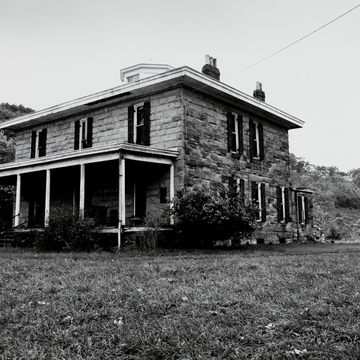You are here
Grape Hill (John J. McCausland House)
As impressive as it is idiosyncratic, this massive house reflects its eccentric builder's talents and interests. Almost brutally plain, it is built of a warm-hued, rock-faced sandstone quarried on the property, hauled to the site, then laid in regular courses. The house is stylistically retardataire: its rigid symmetry, plain cornice, and shallow hipped roof centered with a monitor reflect Greek Revival traits that were popular decades before it was built. On the other hand, it incorporated features quite advanced for its time and place, including a rope-pulled elevator between the first and second floors and a system of flues that made it possible to collect fireplace ashes at a single point in the basement.
As might be suspected, the house was designed by someone with a major in engineering and perhaps a minor in architecture. McCausland (1836–1927) majored in engineering at the Virginia Military Institute, graduating first in the class of 1857. As a Confederate general, he gained a measure of infamy when he ordered the burning of Chambersburg, Pennsylvania, in July 1864, partially in retaliation for the Union burning of his alma mater a month earlier. After the war, he sojourned abroad as an unreconstructed rebel, returning eventually to Mason County—where he had grown up—and building Grape Hill. When asked if he had built the cupola on his house so he could “scan the surrounding area for lurking assassins” seeking revenge for the burning of Chambersburg, McCausland matter-of-factly replied: “The cupola was a cooling system of my own invention. Warm air goes up, and on hot evenings we would open the windows in the cupola for the warm air to pass out, and open the windows and doors on the ground floor to let the cool air come in, and soon we had a comfortable house.”
Grape Hill is currently in poor condition, and the Preservation Alliance of West Virginia has identified it as one of the state's most endangered historic properties.
Writing Credits
If SAH Archipedia has been useful to you, please consider supporting it.
SAH Archipedia tells the story of the United States through its buildings, landscapes, and cities. This freely available resource empowers the public with authoritative knowledge that deepens their understanding and appreciation of the built environment. But the Society of Architectural Historians, which created SAH Archipedia with University of Virginia Press, needs your support to maintain the high-caliber research, writing, photography, cartography, editing, design, and programming that make SAH Archipedia a trusted online resource available to all who value the history of place, heritage tourism, and learning.














